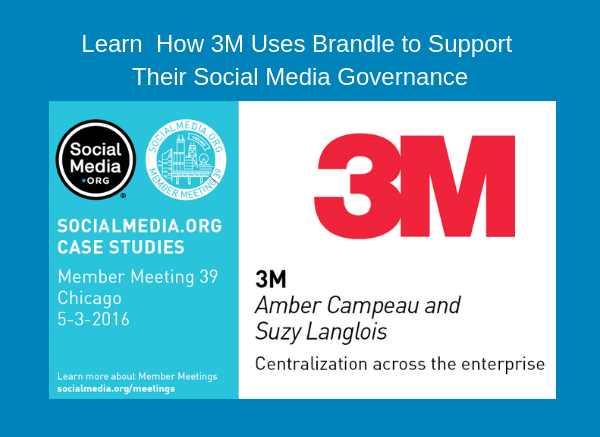Quickly! Think about how you manage your social media.
I bet what came to mind was some collection of content publishing, listening, or analysis systems. If you're in a regulated industry then perhaps a content compliance or archiving system might have come to mind.
What's the common denominator? Content. That's not a bad thing since sharing content is why we're on social media. However, we're overlooking a fundamental component – Presence!
Before we can share content, we must have a presence. Most of us take our social media presence for granted but we shouldn't. Ask yourself a question: What is a presence to our enterprise? The answer is: A-P-B – a social media point of presence is a corporate asset because it's a web property that represents our brand.
Now think about how you track and manage your traditional corporate assets like equipment, trademarks or patents. Are you doing the same for your social assets? Do you know which social assets your employees have created or acquired? Have those assets been properly assigned to the company? Are you monitoring and tracking them - not just the content but the assets themselves? Do they properly represent your brand(s)? Finally, are people creating properties outside your corporation and improperly linking them to your brand?
If you don't think this is important, consider the following statement from Deloitte's 2013 Global Risk Survey:
"Reputation risk is now the biggest risk concern, due in large measure to the rise of social media, which enables instantaneous global communications that make it harder for companies to control how they are perceived in the marketplace".
If you started thinking about content when you read that, that's the natural reaction...and part of the problem. Before we can share content, we have to have to have a presence and that begs a few questions: Who created that social property? Who controls it? Is he or she related to the enterprise? If so, how? For any particular presence, can someone link it to our business? Is that what the enterprise wants?
Believe it or not, answering those questions is harder than one thinks – depending on who created or now controls the presence. Was it:
- an authorized employee at HQ?
- an authorized employee on the front line, possibly in another region or country?
- an unauthorized or rogue employee?
- a past employee who no longer works for the company?
- an agency - current or past?
- a fan or advocate of your brand?
- a channel partner?
- a rogue agent who does not have your best interests in mind?
Now think about all the things a social presence can represent:
- a brand (e.g. Coca-Cola)
- a product (e.g. Diet Pepsi)
- a division (e.g. Autodesk Brasil)
- a team (e.g. Cisco Social)
- an employee (e.g. Zappos.com CEO -Tony)
- a technology (e.g. Google Android KitKat)
- a retail store or channel (e.g. WholeFoods Sonoma)
- a campaign (e.g. Intel Challenge)
- an event (e.g. Maker Faire Rome)
- a community (e.g. Pfizer Employees)
Now consider all the places those things can be represented like Twitter, Facebook, Google+, LinkedIn, YouTube, Vimeo, Flickr, Instagram, Tumblr, Pinterest, Yelp and the list goes on...getting longer with each new social platform.
At Brandle, we have learned that even the most sophisticated companies are challenged to keep abreast of the "points of presence" (POPs) which comprise their social footprint and extended social relationships. This is especially true for companies with large or distributed workforces as well as those which may have experienced a moderate level of employee turn-over or agency churn. We also have observed acquiring companies struggle to identify and transfer all of the acquired company's social presence into its own inventory. Finally, the challenge and risks associated with overseeing the corporate and employee social footprint is greatly magnified for any company operating in a regulated industry like finance, healthcare or alcoholic beverages.
Whether an enterprise is trying to limit its risk exposure, acquire another business, re-brand itself, or just get a handle on its social footprint, companies need to think about how they track and manage their social presence. As the old adage goes, "what you don't know can hurt you!" Therefore, every enterprise should be conducting four (4) key inquiries on an on-going basis:
- What is our social footprint and the social ecosystem around it?
- Does our social footprint accurately represent us and is it consistent and stable?
- Is our presence compliant to brand and regulatory standards?
- Will we know when a new presence is created which seems connected to our enterprise?
There are three ways companies generally deal with tracking their social footprint.
The first, called the "Bureaucratic Method", requires an employee to abide by a set of guidelines and submit a request to get approval from a central authority prior to creating a new presence. As you can imagine, this system depends on the honor system and a fear of reprisal for it to work properly. It is also a system that requires a significant amount of training and oversight to maintain and all it takes is one person to intentionally or accidentally step outside the system for it to break down. Additionally, it does not address the behavior of those who operate outside the enterprise. Finally, the results are generally stored in a spreadsheet which is tedious to maintain and thus highly susceptible to errors.
The second, called the "Manual Audit Method" (aka "Interns on Keyboards"), requires periodically putting together teams of people (or hiring an outside agency) to perform a brand presence audit. These teams try to find every point of presence on the web which might be linked to the enterprise by canvassing employees and searching the web using a collection of words and phrases they think are applicable. While this process could be automated to some degree, it's generally not and like the first method, the results are generally kept in a spreadsheet which soon gets out of date. Additionally, because of the tedious nature of the work, cut-n-paste errors easily creep into the spreadsheet as there are few, if any, data validations.
The third and final, called "Automated Brand Presence Management", utilizes a software system to provide comprehensive oversight of an enterprise's social ecosystem. This is a comprehensive and adaptive system that learns about your enterprise – its brands, products, employees, places, etc. – to discover, manage and monitor the owned and related social properties. It is also your sentinel on the web, constantly looking for new points of presence which appear to be related to your enterprise in one of the ways described above. In a web of global brands and social networks of millions and hundreds of millions of people this is the only scalable solution.
The social web is powerful because of all the ways and places our organizations can be represented to connect with our customers. However, that is precisely what makes it such a headache to manage and why it exposes our businesses to risk as well as reward. We've spent the last 5-8 years producing content and building relationships on these social outposts; now it's time to put the systems in place to track and manage all these assets.









